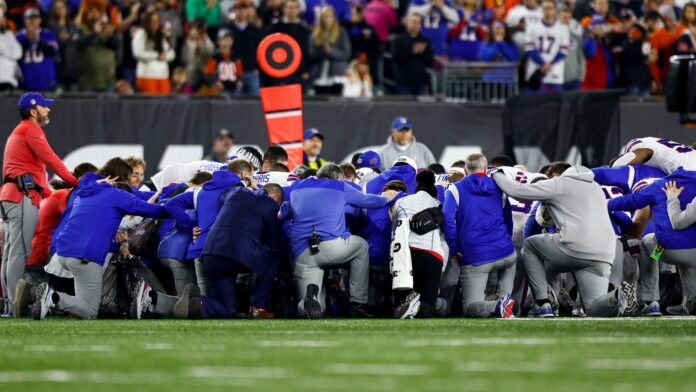Damar Hamlin’s cardiac arrest during an American football game highlighted the dangers elite athletes face.
The news that Damar Hamlin, an American football star with the Buffalo Bills team, suffered a cardiac arrest during a game on Monday night came as a shock to many sports fans.
After the 24-year-old NFL player collapsed, cardiopulmonary resuscitation (CPR) was administered and Hamlin’s heart was restarted, but he remains in hospital in a critical condition.
Sadly, Hamlin is not the first young and seemingly healthy sports star to suffer a cardiac arrest while on the field.
As is well known, Christian Eriksen, a Danish footballer, suffered a cardiac arrest and collapsed during a match against Finland in the 2020 Euros competition. Eriksen has since recovered and resumed his playing career.
While the term cardiac arrest is familiar, its definition is less well known and it does not mean the same thing as a heart attack.
What is a cardiac arrest?
The British Heart Foundation (BHF), a UK charity, describes cardiac arrest as when the heart stops pumping blood around the body and the person ceases to breathe normally. A cardiac arrest may be the result of a heart attack, but this is not always the case.
According to the American Heart Association (AHA), a cardiac arrest “occurs suddenly and often without warning”. It results from an electrical malfunction in the heart that causes an irregular heartbeat, known as an arrhythmia.
“With its pumping action disrupted, the heart can’t pump blood to the brain, lungs and other organs,” the AHA says.
“When this occurs, a person loses consciousness and has no pulse. Death occurs within minutes if the victim doesn’t receive treatment.”
The cause of Hamlin’s cardiac arrest is uncertain, but, particularly in contact sports, a player may suffer a cardiac arrest if they are struck in the chest.
Another cause in athletes is hypertrophic cardiomyopathy, an often-undetected thickening of the heart muscle that can lead to arrhythmia.
Damar Hamlin collapses during NFL game – in pictures
:quality(70):focal(3689x1980:3699x1990)/cloudfront-eu-central-1.images.arcpublishing.com/thenational/LPKHZCMPYIVETW5KP6IHH5RHTU.jpg)
What is a heart attack?
A heart attack, the BHF says, happens when one of the coronary arteries ― the blood vessels that supply the heart muscle with oxygenated blood ― becomes blocked.
Usually, according to the Mayo Clinic in the US, a build-up of fat, cholesterol and other substances causes this blockage. These deposits of cholesterol and other substances are known as plaque.
If plaque ruptures, it may lead to the formation of a blood clot, which in turn can further narrow an artery or block it completely.
Because the part of the heart muscle supplied by that artery is not getting the oxygen it needs, it may begin to die if the person is not treated and the artery reopened.
Symptoms may start quickly and be intense, the AHA says, or begin slowly and initially be mild. These symptoms may include discomfort in the chest or other parts of the upper body, shortness of breath, a cold sweat, nausea or lightheadedness, but there may be no symptoms at all.
What is the link between a heart attack and a cardiac arrest?
Usually, a heart attack does not cause the heart to stop beating, although it may result in cardiac arrest because it can lead to a dangerous abnormality in the heart rhythm. A person may also suffer a cardiac arrest while recovering from a heart attack.
But, the AHA explains, a wide range of other conditions can cause a sudden cardiac arrest. These include arrhythmias (such as ventricular fibrillation, when the heart’s bottom two chambers, the ventricles, contract in a rapid, unco-ordinated way), a thickened heart muscle, and heart failure (which means the heart is not pumping properly).
If a person is experiencing a suspected heart attack or cardiac arrest, the emergency services should be called. With a cardiac arrest, the AHA advises people to also call for or get an external defibrillator if possible and use it immediately.
The organisation additionally suggests that people begin “high-quality” CPR and carry on with this until the emergency services arrive.
When Eriksen suffered the cardiac arrest, CPR was administered and his heart was reset with an automated external defibrillator.
In a later operation, he was fitted with an implantable cardioverter defibrillator (ICD), a small device placed under the skin, typically just below the collarbone, attached to the heart with thin wires.
If the ICD detects an abnormal heart rhythm, the device administers low-voltage electrical impulses or one or more small or large electric shocks to reset the heartbeat.



:quality(70)/cloudfront-eu-central-1.images.arcpublishing.com/thenational/ISAULSNHUJKLMZXJLRMGRG5TLE.jpg)
:quality(70)/cloudfront-eu-central-1.images.arcpublishing.com/thenational/SSPJOFXZKFQK7PFATPLYOYY34Y.jpg)
:quality(70)/cloudfront-eu-central-1.images.arcpublishing.com/thenational/OL2OKW2NXNZNAX3P7PQNI5NNME.jpg)
